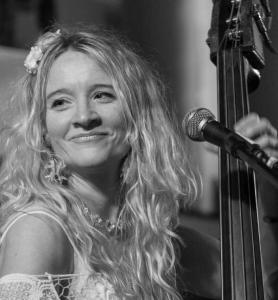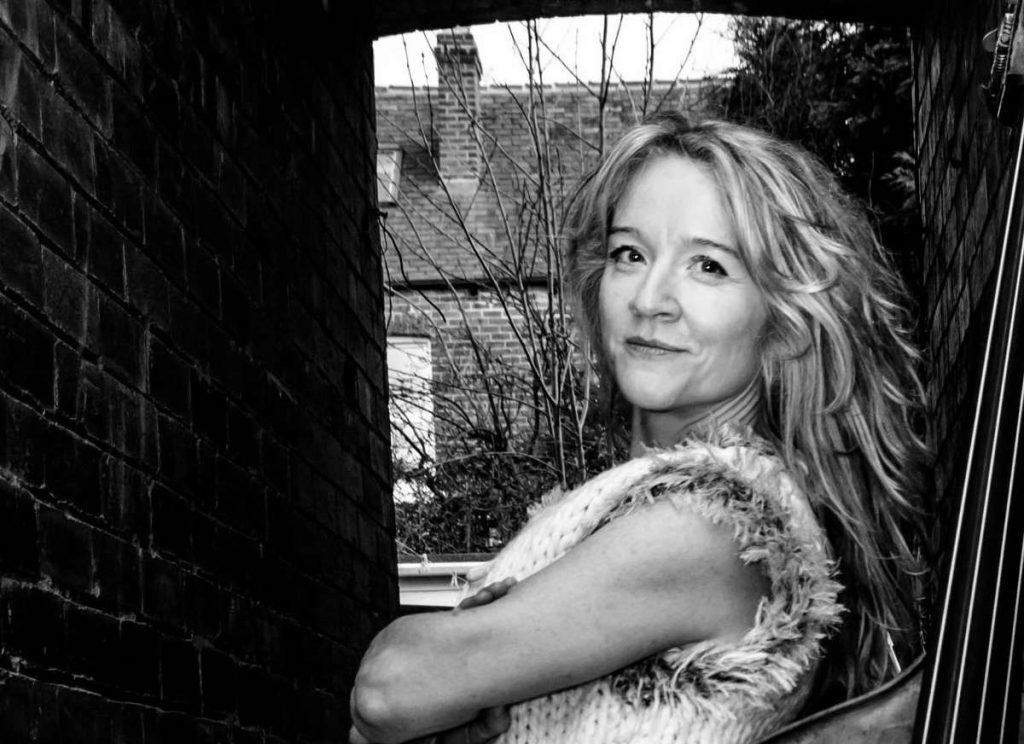 Nicola Farnon is surely living most musicians’ dream. In demand throughout Europe, the well-travelled jazz singer and bassist toured Ukraine last month. She has played with the likes of Sir John Dankworth and Dame Cleo Laine, but her Nicola Farnon Trio (sax/piano: Piero Tucci, drums: Phil Johnson) still frequents the Sheffield bars where I first encountered it, eight years ago. I couldn’t say how many times I’ve grooved to Nicola’s solid, swinging rhythms since then, but we never exchanged more than passing pleasantries.
Nicola Farnon is surely living most musicians’ dream. In demand throughout Europe, the well-travelled jazz singer and bassist toured Ukraine last month. She has played with the likes of Sir John Dankworth and Dame Cleo Laine, but her Nicola Farnon Trio (sax/piano: Piero Tucci, drums: Phil Johnson) still frequents the Sheffield bars where I first encountered it, eight years ago. I couldn’t say how many times I’ve grooved to Nicola’s solid, swinging rhythms since then, but we never exchanged more than passing pleasantries.
Her stage presence is wonderfully warm and upbeat—so it was a great joy to find her equally cheerful when we sat down to chat at a Sheffield pub. Nicola has no cause to be as endearingly modest as she is. The late, great Humphrey Lyttelton (with whom she also shared a stage) once called her “a class act” who “should be on every jazz festival in the land.”
With eight albums behind her, Nicola’s tastes and talents run the gamut of jazz and beyond—but she keeps swinging back to the Great American Songbook. “I think any good music must have an element of swing,” she told me. “Even classical—I always liked Brahms, because his cello has some syncopation in it.”
Nicola’s journey into jazz might be called inevitable, being a great-niece of Robert Joseph Farnon CM. The trumpeter, composer and arranger was the Canadian Glenn Miller, conducting the Canadian Band of the Supreme Headquarters Allied Expeditionary Force. A longtime friend of Dizzy Gillespie, Robert scored 40 movies and wrote three symphonies, winning a Grammy, four Ivor Novellos, and the Order of Canada.
But classically-trained Nicola came to jazz surprisingly late. “I didn’t even hear any until I was studying performing arts at Middlesex Polytechnic,” she said. “I took some jazz piano there and it just opened doors in my head to all sorts of music that I hadn’t even known about.
“There was a double bass there that I would pick up and play with. Thanks to the cello, it wasn’t completely alien to me.” Bass quickly became Nicola’s passion. “I was a big funk fan, so I was very aware of the bottom end and how it underpinned everything,” she said.
“Someone advised me to listen to all these jazz double bass players like Paul Chambers, Ray Brown, and Ron Carter. That started me on a journey away from classical, which I was rebelling against, but I’m so grateful for that training now because I can write and arrange. It’s put me in control of the music in a way I wouldn’t have been otherwise. I didn’t realize how important it was until I started taking jazz seriously, in my thirties.”
Her recent record, So Farnon So Good, with the Nicola Farnon Quartet (guitar: Jim Mullen, piano: David Newton, drums: Steve Brown), is a more contemporary, Latin-infused collection. But her back catalogue with the Nicola Farnon Trio is awash with swing classics by the old masters. “At
Last,” “Lady is a Tramp,” “Let’s Fall in Love,” “How High the Moon,” “Cheek to Cheek,” and “Bye Bye Blackbird” all appear there.
“Swing was the pop music of the day,” she said, “but it was incredibly sophisticated and stands the test of time in a very impressive way. These composers had such a complete and wonderful grasp of writing lyrics, melody and harmony.”
She added: “I’m inspired by so many people. When I listened to Paul Chambers I really started to understand swing. Count Basie was definitely a huge influence too. I got the album Ella and Basie and that was just amazing. As far as singers go, it was Ella Fitzgerald, Anita O’Day, Nancy Wilson—singers with swing, who push it a bit.”
The Ella inspiration is strikingly obvious in Nicola’s gymnastic voice, which possesses both the First Lady of Song’s sweet smoothness and powerful punchiness. “Because I’m singing and playing bass, I feel like I’m controlling both ends,” she said. “That makes me sound like a bit of a control freak! Perhaps I am.”
Touring UK and European jazz clubs is a constant stream of career highlights, Nicola says. “There are always highlights because there’s always the hope of improving in your art. There are just moments, and they’re not always what you expect. You can play a big gig and you can’t generate that much feeling. The smaller ones tend to have more atmosphere. You come away thinking that was brilliant. I really enjoy playing swing dance nights because everyone is just having such a great time.” Something I was relieved to hear, as a keen dancer.
She added: “Ukraine was a really exciting adventure. We went on lots of night trains. That was a very different experience. Being a musician you turn up in all sorts of places and see things many people don’t see. Most musicians have a very good grasp of geography and that’s a privilege.”
Despite her successes so far, her sights are turned firmly upwards. “I’ll never reach as high as I would like to, which is how it should be,” she said. “I think if you ever reach a place where you’re thinking ‘that’s it, I’m there,’ then I think people would be astonished by that. Because there’s always someone who is miles better. That’s what being a musician is—it’s the torment and the torture of improving at your craft.”
Humble Nicola is quick to acknowledge and admire the other women occupying her small niche of jazz singer and bassist. “There’s an amazing singer-bassist called Nicki Parrott, who I love,” she said. “But the jaw-droppingly unbelievable one is Esperanza Spalding. She’s phenomenal. She’s a fantastic singer, bassist, composer, guitarist. She’s so eclectic—she’s in a completely different league to me.”
Post-war jazz innovators influence Nicola’s style, but she yearns to take her jazz in an even more retro direction—inspired by her famous namesake.“Robert had such an amazing arrangement style, which is something I’m looking into more and more,” she said. “I’d like to pick 12 songs from my albums and do big band arrangements of them, then tour them. That would take a lot of funding, but I’m looking into that now. It would be bloody amazing to do that! But the biggest I’ve ever written for is a six-piece, so it would be quite an investment in time learning.”
Knowing what she can do with just two or three bandmates—plus her ever-present double bass—I know the wait will certainly be worth it.
Dave Doyle is a swing dancer, dance teacher, and journalist based in Gloucestershire, England. Write him at davedoylecomms@gmail.com. Find him on Twitter @DaveDoyleComms.






















